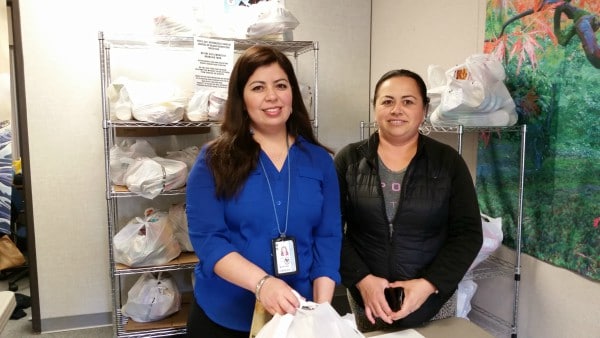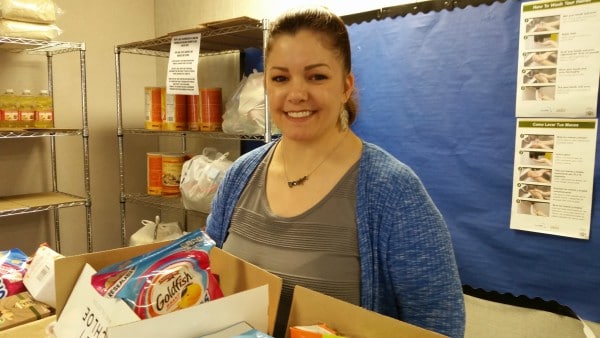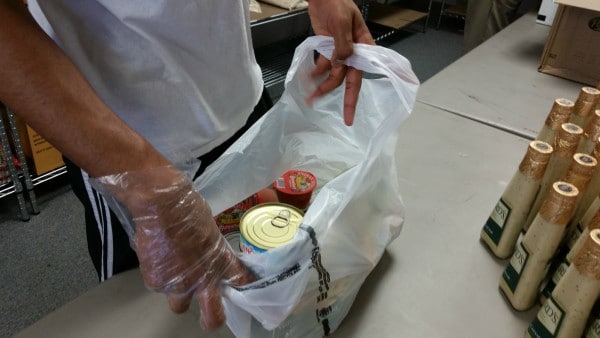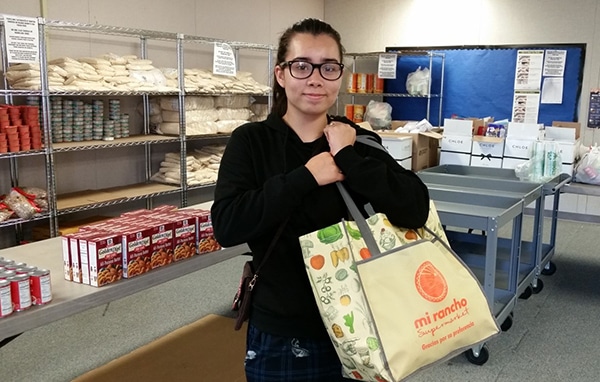Alejandra and her mother pick up free groceries at her high school every Monday afternoon. The 17-year-old junior hopes to someday be an engineer in the aerospace industry. Her dad works hard, but the cost of living in Silicon Valley is high and everything is expensive. The food helps her family of six get by.
“Nutritious food makes me feel so much better,” she said. “It makes it easier to concentrate and focus on school work.”
The pantry opened at Oak Grove High School in January and serves about 300 families every month. It’s located in one of the portable buildings on campus. Second Harvest keeps the pantry stocked with shelf-stable staples like rice, beans, pasta, canned fruits and vegetables, canned tuna and cooking oil. Once a month, families also receive fresh produce.
“I think the perception is that because we’re in South San Jose, everyone is fine,” said Valarie Ikemoto, a social worker at Oak Grove who runs the pantry with Martha Cabrera, parent involvement specialist. “But there is a lot of need. We have a high number of multiple families living in one home.”

Martha Cabrera, parent involvement specialist at Oak Grove is pictured with Maria, an Oak Grove student’s parent.
Maria, an Oak Grove student’s parent and neighborhood resident, says the food is a big help to her and her family. In fact, childhood hunger is a big problem in nearly every neighborhood in Silicon Valley, where more than 1 in 3 students qualify for free or reduced-price school meals. The high cost of living – particularly housing – is making it difficult for families like Alejandra’s and Maria’s to pay rent and put food on the table.
Investing in Solutions
Second Harvest launched its tailored school solutions initiative three years ago to address the huge increase in kids and families who need food. This intensive effort to open a network of school pantries – where families can pick up groceries and fresh produce right in their own neighborhood, learn more about nutrition, and get connected to other resources like CalFresh (food stamps) – is paying off. Last year the Food Bank opened 27 school pantries, a record number.
The Food Bank is now serving 108 K-12 schools and 10 colleges through our school pantry program, with plans to open five more school pantries this year.
“We realized years ago that schools are a great place to reach families,” said Leslie Bacho, CEO for Second Harvest of Silicon Valley. “Families are familiar with their local school, it’s a trusted place, and conveniently located right in their own neighborhood. So we stepped up our effort to partner with schools, which have a vested interest in making sure their students have access to nutritious food.”
Hungry kids often struggle to concentrate at school, depriving them of a decent education. Hunger has been linked with delayed development and learning difficulties. Children who struggle with hunger are also at higher risk for health complications as well as behavioral issues, anxiety and mood swings. But studies also show that low-income kids who have access to food assistance are healthier and perform better at school than other low-income kids who don’t.
“Kids need nutritious food to function at school in general, to be able to focus and concentrate,” said Ikemoto, who has seen it firsthand. “Hunger is linked to disciplinary problems. Students get sent to me for behavioral issues, and then when we dissect it, we find out there is a lot more going on, and one of them is access to food. If they can’t concentrate and follow along in class, they are much more likely to act out.”


Valarie Ikemoto runs the pantry with Martha Cabrera.
Over the last five years, Second Harvest has invested nearly $2 million to build the capacity of its partners to distribute more food, including schools. The Food Bank has purchased refrigerators, freezers, hand trucks, shelving, and other equipment and infrastructure to specifically enhance its school pantry network.
Carts Come in Handy
The Food Bank purchased three rolling carts for Oak Grove High School to make it easier to stock the pantry shelves.
“Second Harvest delivers food the first and third Wednesday of the month,” Ikemoto said. “We get fresh produce once a month. This month was awesome – we got Brussels sprouts, artichokes and bell peppers.”
On a recent Monday afternoon, the pantry was in full swing. Three student volunteers were busily packing up bags for other students and families. Two of them were actually serving detention.

A student volunteer helps to bag the food.
“Kids can serve their detention by helping out with the pantry,” Ikemoto said. “If we can get kids there, handing out fruit, engaging people in a positive way, that’s way more impactful than sitting in a room. It’s great being able to praise them. Finding strengths in them through actively giving back is really powerful for them. And before they leave, I tell them to take a bag of food.”
Stand Up for Kids
Second Harvest’s Stand Up for Kids Campaign helps to support these efforts. This year the goal is to raise $7.7 million to open more school pantries, purchase the kinds of foods kids need to grow up strong and healthy, and explore new and innovative ways to connect more kids and families to food.
“The numbers add up very quickly when you provide food on the massive scale that Second Harvest does,” Bacho noted. “For example, providing another half gallon of milk each month to every child we serve would cost about $2 million a year.”
What can you do?
- Help others see child hunger by sharing this blog
- Encourage people to contact Second Harvest if they need food
- If your kids’ school doesn’t offer breakfast or a summer meal program, talk to administrators about starting one
- Support policies that ensure everyone has access to nutritious food
- Get involved in our Stand Up for Kids Campaign
